[wptabs]
[wptabtitle]2007[/wptabtitle]
[wptabcontent]
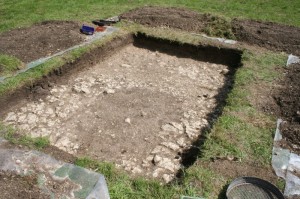
2007 test pit.
[/wptabcontent]
[wptabtitle]2008[/wptabtitle]
[wptabcontent]
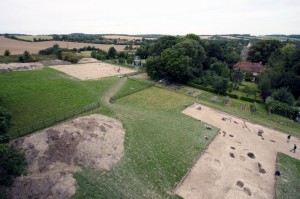
Aerial shot, 2008 trenches.
[/wptabcontent]
[wptabtitle]2009[/wptabtitle]
[wptabcontent]
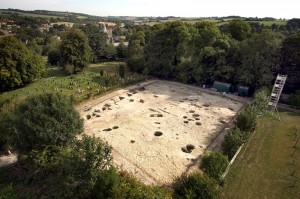
Aerial shot, 2009 trench.
We identified several boundary ditches and smaller palisades during this season. They indicate that this portion of the monastic settlement had a planned rectilinear arrangement. The timber buildings in this area had consistently small floor-plans. This suggests that they may have been monastic ‘cells’, home to an individual monk or nun. They were surrounded by dense clusters of pits holding human waste and kitchen rubbish. Several of the artefacts discarded in these pits were domestic furnishings such as door hinges and keys.
[/wptabcontent]
[wptabtitle]2010[/wptabtitle]
[wptabcontent]
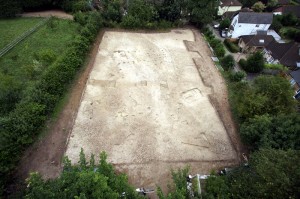
Aerial shot, 2010 trench.
In the same season we also had the opportunity to open up a series of evaluation trenches in land to the west of the churchyard. The key discovery was a Middle Saxon ironworking site located around 150m to the north-west of the Anglo-Saxon monastic nucleus. This find indicates that the manufacture of iron tools and implements formed a crucial component of the monastic economy, with the potential that some of the output was sold to generate a financial income.
[/wptabcontent]
[wptabtitle]2012[/wptabtitle]
[wptabcontent]
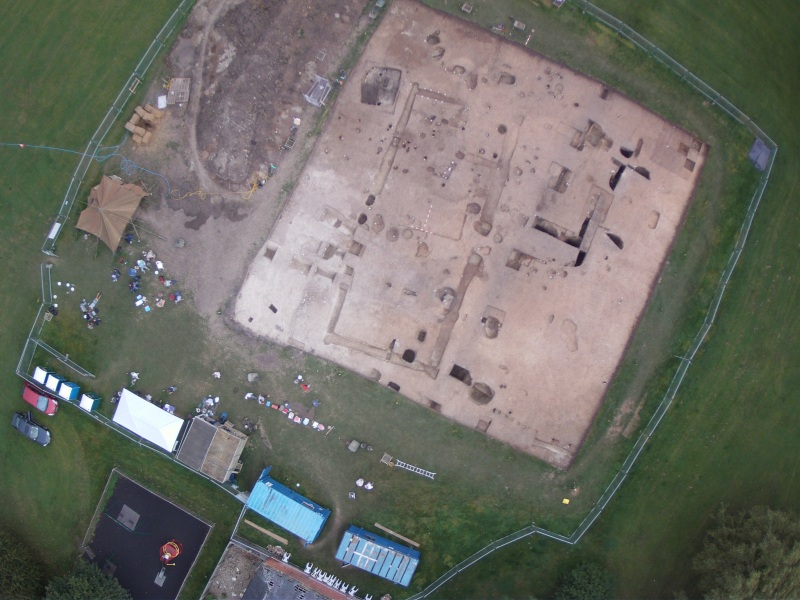
Aerial shot, 2012 trench.
One of these halls turned out to be one of the star finds of the project. Measuring 21×8.5m and of so-called post-in-trench construction, this structure represents one of the most important Anglo-Saxon buildings yet excavated in Kent. It has been dated to around AD600 (to be confirmed by radiocarbon dating) and belongs to a rare class of high-status hall. This design was common to Anglo-Saxon royal complexes, used for holding ceremonial feasts and assemblies of the type described in the poem Beowulf.
This imposing hall was constructed on the plateaux of a low spur bordered by the spring and encircling headwater of the River Nailbourne. This seems to have been a strategic spot and our excavation demonstrates that this is the longest inhabited portion of the village. In addition to Anglo-Saxon occupation we encountered extensive scatters of prehistoric flint dating to the Mesolithic period (c.8000-5000 BC) and also dense clusters of latrine pits, boundary ditches and structural remains dating to the ‘Saxo-Norman’ period (late 11th-late 12th centuries AD).
[/wptabcontent]
[wptabtitle]2013[/wptabtitle]
[wptabcontent]
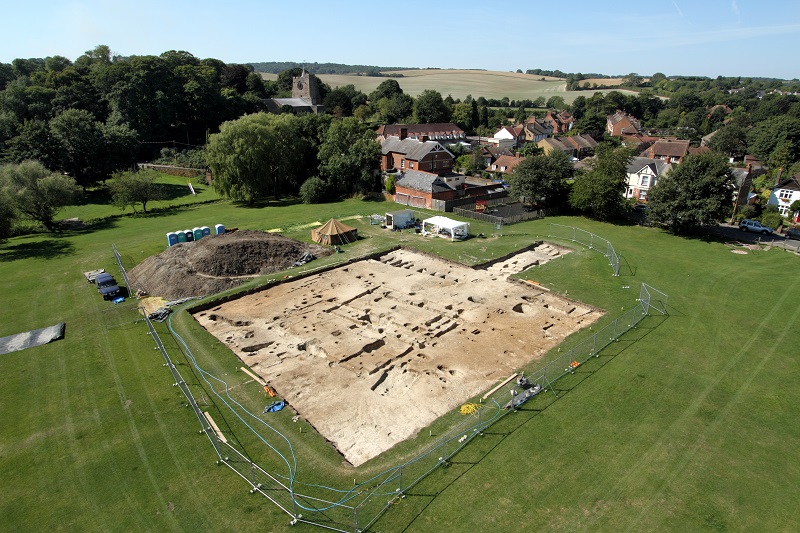
Aerial shot, 2013 trench.
Yet again, the excavations surpassed our expectations. This year we discovered two sunken-featured buildings and four timber halls. Three of these timber halls were discovered in their entirety, with overlapping floor plans. Laid out on a perpendicular alignment to 2012’s ‘feasting hall’, this imposing structure was rebuilt from scratch on three successive occasions, growing in scale and complexity over time. In its final and most elaborate phase, the hall measured c.15x7m, with enormous doorway pits dug for substantial entrances into the building mid-way along the long walls. Evidence for the presence of a mortared floor of the type usually found in 7th century churches was also discovered.
A fourth east-west oriented timber hall was discovered in a western extension to the main trench in the vicinity of the World War II archaeology. Although only the north-east corner and a length of long wall were uncovered, it is clearly a substantial building, as indicated by very large flint-packed raking posts and unusual triple rows of planks set into the long wall. The sizable dimensions of this long wall suggests that it might be on an even larger scale than the timber ‘feasting hall’ discovered in 2012, and its precise alignment indicates that it, along with the north-south hall-sequence excavated in the main trench, is very likely to belong to a contemporary complex of buildings.
In addition to the impressive Anglo-Saxon structures and World War II mess huts, early Saxon latrine pits and 11th-12th century ditches, pits and post holes were also uncovered in 2013, adding much to our picture of Lyminge as place of long-term settlement.
[/wptabcontent]
[wptabtitle]2014[/wptabtitle]
[wptabcontent]

Aerial shot, 2014 trench.
This year, we were able to identify three phases in the reopened east-west oriented Timber Hall. Two phases used plank-in-trench construction techniques, whilst the third and final phase used raking timbers on the outside of the building. The full width of the hall was established as 12m, while the full length is unknown but thought to be over 20m long. A mortared floor such as that identified in the largest phase of the 2013 north-south oriented Timber Hall appears to have been present in at least one of the phases of this hall, with fragments of cement-like floor material (pseudo-Opus Signinum) present in wall trenches and post pits.
The trench over the Bronze Age Barrow (which contained five cremations at its centre) yielded some extremely exciting archaeology, with the excavation of several phases of a 6th century post-built hall oriented east-west, likely to be contemporary with the sunken-featured buildings found in previous seasons. The geophysical anomaly was identified as an artefact-rich midden with some depth, a type of feature previously unknown from Anglo-Saxon England. This midden area measuring some 12x15m, contained a wealth of material, including hundreds of glass fragments, copper alloy and iron objects, animal bone, huge amounts of slag and kiln or hearth lining and early Saxon decorated pottery, amongst layers of significant burnt material dumped in, and at least one in situ hearth. North-south and east-west slots were dug through the midden and a depth of 1.8m was reached, with a layer of flint nodules overlying particularly clean clay. The origins of this feature are at present still unclear as the bottom of this feature was not reached.
As well as these Saxon and Bronze Age features, a crouched inhumation of the Beaker period (c.2500-1800 BC) was unexpectedly discovered, along with Saxo-Norman and Medieval pits and ditches, World War II structures, and a quantity of Mesolithic flints, part of the flint scatter that is present across the whole site.
[/wptabcontent]
[/wptabs]




